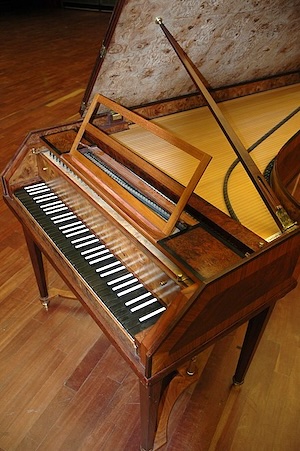Top > Instruments > Tangent Piano
This site introduces unknown composer Emanuel Bach (C. P. E. Bach). This English version was translated from Japanese one by ChatGPT.
Tangent Piano
ChatGPT4o writes as follows (please note that it may not be accurate):The tangent piano is a type of keyboard instrument that was used in Europe from the late 18th century to the early 19th century. It emerged as part of the development of keyboard instruments alongside the harpsichord and the fortepiano. Its most distinctive feature is its mechanism: when a key is pressed, a small metal or wooden bar called a “tangent” strikes the string directly.
Since the tangent remains in contact with the string after striking it, the sound has a relatively short sustain. While the tangent piano offers better control over volume and tone compared to the harpsichord, it lacks the dynamic range of the fortepiano. However, like the fortepiano, it is equipped with a damper function, allowing the strings to vibrate freely and sustain the sound.
This instrument was particularly well-suited for music of the Empfindsamer Stil (Sensitive Style), and composers like Carl Philipp Emanuel Bach and his contemporaries made use of it. The instrumentʼs expressive sound matched the subtle nuances of this musical style perfectly.
However, due to its structural limitations in volume, the tangent piano was unsuitable for large performance spaces. As a result, it was gradually replaced by the fortepiano, which offered greater volume and expressive capability, and it eventually disappeared in the 19th century. Today, restored instruments are used in performances by specialists and early music enthusiasts.

The concept of striking strings with a keyboard mechanism dates back to the 15th century. This gives the tangent piano a long history, predating the early piano invented around 1700 by Bartolomeo Cristofori. Fragmentary documents from the 16th and 17th centuries confirm the existence of instruments similar to the tangent piano, though the extent of their popularity remains unknown. Harpsichords and clavichords were likely the more common keyboard instruments during that time. Cristoforiʼs invention marked a significant turning point in piano history, being recognized as the first instrument to use hammer action.
There is considerable interest in how early keyboard instruments struck their strings—specifically, how hammers or “tangents” (small rods that strike the strings) functioned. Pivoted hammers and tangents were designed to strike strings directly, moving in sync with the keyboard action. Early design diagrams depict mechanisms that closely resemble those found in modern pianos. However, due to the scarcity of surviving instruments, fully understanding these mechanisms remains challenging.
Records of the tangent piano increase during the 18th century, yet the available information is still limited, leaving many questions unanswered. Nevertheless, it is highly likely that mid-18th-century composers such as J.S. Bach and Domenico Scarlatti were aware of these instruments. The tangent piano is characterized by its uniquely bright tone and rich expressiveness. It is believed that C.P.E. Bach found the tangent piano particularly suitable for his musical expression. Emanuel Bach composed music that took advantage of the distinct qualities of both the early fortepiano and the tangent piano. The tangent piano was especially well-suited for his solo works, allowing for clear tone and deep expressiveness.